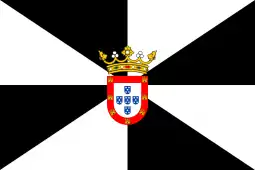Siege of Ceuta (1790-1791)
The Siege of Ceuta (1790 -1791) was an armed confrontation between the Kingdom of Spain and the Kingdom of Morocco during the Spanish-Moroccan War of 1790-1791. The siege of this city was the central episode of this conflict.
| Siege of Ceuta | |||||||
|---|---|---|---|---|---|---|---|
| Part of Spanish-Moroccan War (1790 - 1791) | |||||||
 View of Ceuta during the siege. | |||||||
| |||||||
| Belligerents | |||||||
| Spain | Morocco | ||||||
| Commanders and leaders | |||||||
|
Luis de Urbina José de Urrutia | Sherif Ali | ||||||
| Strength | |||||||
| 12,000[1] | Between 18,000 and 20,000[2] | ||||||
| Casualties and losses | |||||||
| 253 dead [3] | 2,000 dead[4] | ||||||
On September 25, the Moroccan army began to bombard the city. Since a sea attack was impossible, the bombardment's objective was to open a breach somewhere in the walls of the city and penetrate through it. The besiegers established their headquarters in the city's seraglio and installed 14 batteries.[5] However, from the start the bombardment was not continuous since there were ongoing peace negotiations between the two countries.
During the siege, Spanish forces relocated towards Ceuta to reinforce the situation there. Most of these regiments arrived in 1791 between a ceasefire and return to hostilities. The naval forces were also present in Ceuta, providing continuous communication between Ceuta and Peninsular Spain; the gunboats invented by Antonio Barceló were particularly effective.
The meetings between Spanish and Moroccan representatives alternated with military confrontations until October 14, 1790, when a ceasefire was established.[6]
Sultan Yazid of Morocco proposed the suspension of hostilities to negotiate with the Spanish government in Madrid. The ceasefire would last from October 1790 to August 15, 1791. During these negotiations, the two countries took advantage of the ceasefire to resupply their troops and increase their forces. The Moroccan sultan tried to achieve the surrender of Ceuta and some minor garrisons, or a monetary payment in exchange for peace. Charles IV refused these terms and formally declared war on Morocco, restarting the conflict on August 15, 1791.
The besieged noticed that the batteries were not guarded by a large garrison while the city was not being bombarded and organized an escape on August 25. The offensive was carried out in conjunction with the navy, which escorted land forces that left the city to cause massive damage to the Moroccan batteries. In response, the Moroccans launched a major offensive against the city's walls on August 30, when 8,000 men accompanied by the siege batteries attempted unsuccessfully to enter the city.
On September 14, following the directions of the Sultan, Sharif Ali asked to negotiate with the governor of Ceuta as he faced low morale within his ranks. In addition to demoralization, he faced a massive economic cost associated with the siege, and an uprising by the Sultan's brothers who disputed the throne.[7] The Moroccan troops began to retreat in the next days and the city was no longer under bombardment. However, a large part of the artillery in position was not withdrawn. Facing this refusal to withdraw them, the Spanish left twice during September and October, causing skirmishes and casualties on both sides. The skirmishes around the areas used by the besiegers would continue until the signing of a peace treaty.
References
- Carmona Portillo, Antonio. Las relaciones hispano-marroquíes a finales del siglo XVIII y el cerco de Ceuta de 1790-1791. Málaga: Editorial Sarriá. p. 106. ISBN 84-95129-90-6.
- Carmona Portillo, Antonio. Las relaciones hispano-marroquíes a finales del siglo XVIII y el cerco de Ceuta de 1790-1791. Málaga: Editorial Sarriá. p. 121. ISBN 84-95129-90-6.
- Carmona Portillo, Antonio. Las relaciones hispano-marroquíes a finales del siglo XVIII y el cerco de Ceuta de 1790-1791. Málaga: Editorial Sarriá. p. 199. ISBN 84-95129-90-6.
- Carmona Portillo, Antonio. Las relaciones hispano-marroquíes a finales del siglo XVIII y el cerco de Ceuta de 1790-1791. Málaga: Editorial Sarriá. p. 202. ISBN 84-95129-90-6.
- Luis, Jorge (2015). Los conflictos por Ceuta y Melilla: 600 años de controversias. Universidad Nacional de Educación a Distancia. p. 228.
- Carmona Portillo, Antonio. Las relaciones hispano-marroquíes a finales del siglo XVIII y el cerco de Ceuta de 1790-1791. Editorial Sarriá. p. 146–151. ISBN 84-95129-90-6.
- Carmona Portillo, Antonio. Las relaciones hispano-marroquíes a finales del siglo XVIII y el cerco de Ceuta de 1790-1791. Málaga: Editorial Sarriá. p. 297. ISBN 84-95129-90-6.
Bibliography
- Carmona Portillo, Antonio. Las relaciones hispano-marroquíes a finales del siglo XVIII y el cerco de Ceuta de 1790-1791 . Editorial Sarriá
